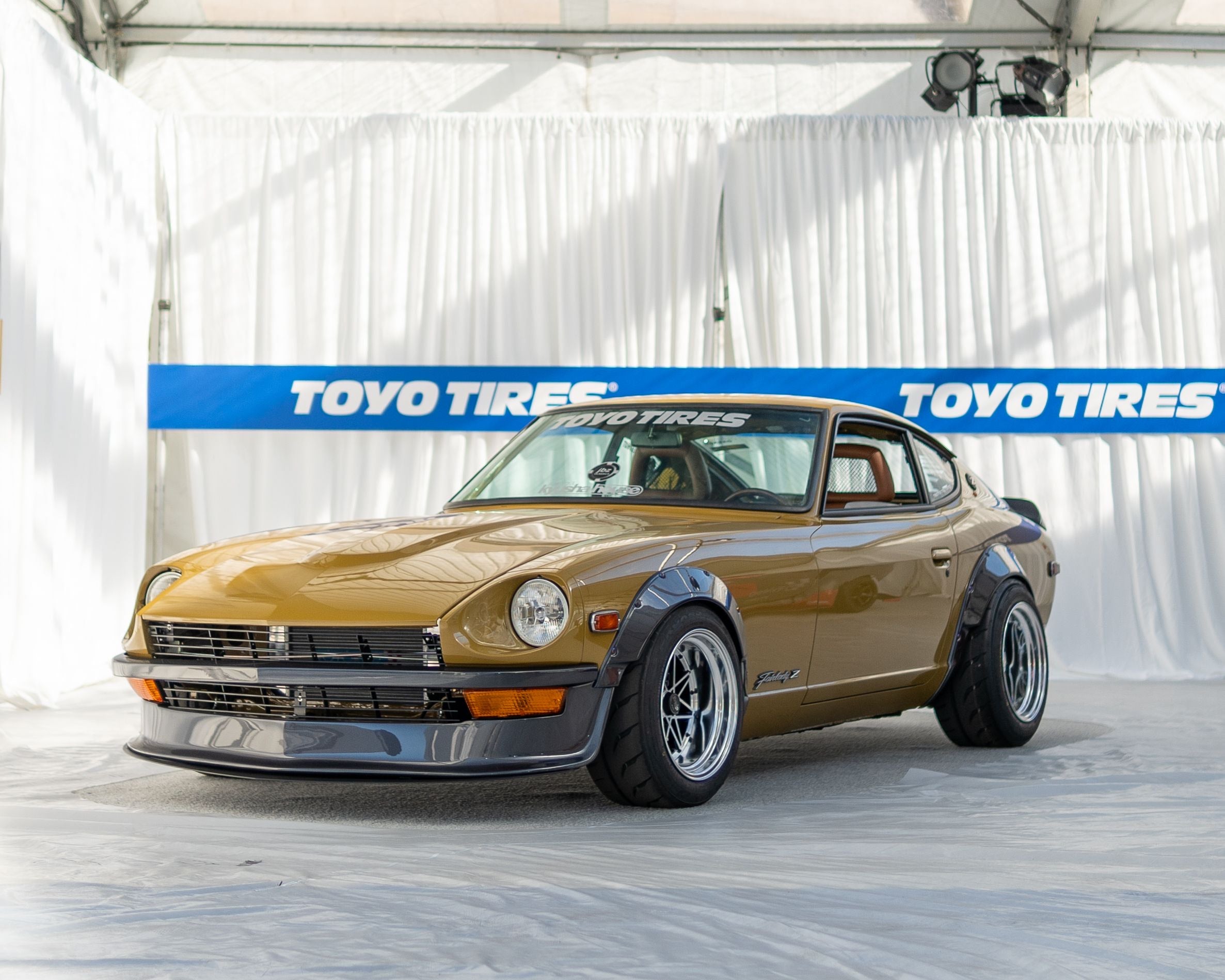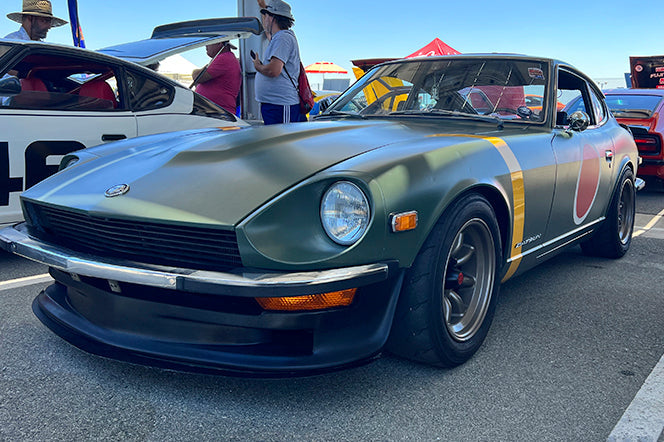Restoring and modifying classic cars is certainly a unique process. You need a fine balance - you need to protect the old-world charm of your vintage vehicle, but you also want to add modern conveniences for a more enjoyable drive.
The electric power assist steering (EPS) upgrade is a popular choice in the Z car community. But is this change a good fit for you?
Slapping modern steering tech in an old car can feel odd to some people. Isn't the appeal of vintage vehicles founded on the driving experience? What if you could improve this experience, and what if your favorite Z car was more fun to drive? Will your car's performance and its potential selling price be affected? Will purists yell at you in the streets?
There are lots of questions here, and it's important to think carefully about each one before you pull the trigger. So, let's talk about the pros and cons of this modification!
Note: This guide will broadly cover the S30 chassis, as these points apply equally to the Datsun 240Z (aka the Nissan Fairlady Z), the 260Z, and the 280Z.
Disclaimer: This article is authored by a member of the Skillard community and reflects their personal views, not necessarily those of Skillard. We welcome your feedback and corrections in the comments to help us continually improve this content.
Table of Contents
Before We Get Started
Think about a few things before converting your car to power steering.
First off, the cost is something you need to think about. It's obviously a lot more difficult than simply buying a couple of parts - you need to tweak other parts of your car, and mechanic fees can add up - if you choose to go that route. And then, let's not forget the unexpected costs that can surprisingly show up sometimes.
Owners of Z cars should think about how installing electric power assist steering could affect their vehicle's performance. Power assist can make steering more sensitive and improve reaction speed. This could make driving easier, like in a busy city environment. Think about how these changes would fit with your driving habits and what you use the car for. What you plan on doing with the car, whether it's for car shows, everyday driving, or fun weekend adventures, all these factors matter.

Installation can be easy or hard, depending on who you ask - different car enthusiasts have different opinions. Some people have a blast doing it themselves, while others would rather have a pro handle these sensitive parts. You need to think about what you can do, what tools you have, and how much time you can dedicate to the project. If you'd rather have a professional install it, then you'll need a highly skilled, reliable mechanic who knows all about upgrading old cars.
Take a moment to think about how the power assist might affect your car's resale value down the line. It's not cut and dried; fitting power assist could make your car more attractive to certain buyers, increasing its value as a "restomod." But people who prioritize keeping things original might prefer a car without the updates, which could lower its value. If you plan on selling your car one day, it's not a bad idea to look into what future buyers might want. If you don't plan on selling your car, then the decision becomes a lot simpler.
For many owners of classic cars, maintaining the traditional aesthetics and historical accuracy of the vehicle is very important. It's important to think about how adding EPS will change the car's original appearance and feel. Would this update necessitate major changes that are easily noticeable, or would it blend in without being noticed?
It's also necessary to consider what long-term maintenance would entail. Like any other part of a car, an EPS system will require regular upkeep. Look into the availability of replacement parts, ease of troubleshooting, and potential future maintenance costs.
Finally, we'll be mostly talking about electric power steering today and not hydraulic power steering. It's better because it doesn't have leaky hoses, power steering fluid, pumps, heavy parts, and so on. It's not very common to see hydraulic power steering kits or conversions online for these cars, so we'll stick to EPS for the purpose of this article.
Still interested? Great! Let's move on to your options, potential challenges, safety factors, performance features, and more.
DIY Approaches and Experiments
A whole lot of DIY lovers have tried many different approaches. Some have had success, others not so much. One project, interestingly, is using Subaru parts to fit the Electric Power Steering System from a BRZ into a 240Z. This idea can be cost-effective compared to purchasing ready-made kits and offers a fun challenge - that is if you're doing the labor yourself.
Others search places like eBay for parts that can be used in new ways. Some enthusiasts found that General Motors parts can be easily used for EPS conversions in the 240Z. Others have had luck using the EPS from the Toyota FRS, Suzukis, Hondas, hot rods, and various other vehicles.

Remember, though, that trouble can potentially pop up if these modern parts don't work well with a classic Z car or if some additional modifications need to be made. There could even be problems that make a project take longer and cost more. And there's always the question of how long these used parts will last - will they hold up, will they be safe, or will they just lead to more headaches? There are a lot of factors.
Some people might not like the idea of dismantling and custom designing - especially those who don't have enough tools or knowledge. These people might think it's a better idea to go with a kit specifically made for the S30. Let's talk about those next.
Commercial Solutions and Their Advantages
Classic Z car fans usually prefer commercial products for installing electric power assist steering (EPS) over trying to fabricate something themselves. Websites like ZPowerSteering offer kits that are easy to work with - even if they cost a bit more - to give these vintage vehicles a modern upgrade. What automotive fans really like about ready-made kits is their no-fuss compatibility, reviews, and results, including the integration of essential components like the steering rack and pinion.
This kit is the one we have installed on the Skillard Z car. One important note is that the kit comes with a knob to turn your power-assisted steering on and off.

This makes it much more dynamic for the driver and alleviates many of the concerns that installing one of these kits has - if you find that your steering is too sensitive (like on the freeway, for example), you can simply turn off the power steering on the fly. If you're straining to navigate a parking lot at 3 miles per hour, you can turn it back on - it's super convenient.
Happy customers give us a lot of reasons why they went the commercial route. One big reason is how easy the kits are to install. These kits often include a meticulously designed steering rack, durable bushings, and a compatible linkage system, making them perfect for your Z car model and easier to set up, as they are specifically designed for your vehicle and have all of the parts you'll need. This easy installation is a big hit with people who don't know a lot about car mechanics or those who just prefer a solution that doesn't need a lot of work.
People using these kits are always talking on the forums about the improved steering response, a new, modern driving feel, and the transformation in the steering wheel handling experience. Most people agree that these kits are a good balance of better performance and keeping the car's classic feel.

But these commercial kits aren't always perfect. One major downside is the cost. The kits are usually more expensive than parts you'd buy for doing it yourself. And even though they're easier to use, you still need some mechanical skills to make sure everything gets set up right, including aligning the steering rack and ensuring the bushings and linkage work harmoniously with your existing system.
You'll also have to read reviews and choose carefully; the kits that you'll see on sites like eBay are not all made equally. Some are very low quality, and others are built like tanks. Make sure that you do your homework!
So, these kits can be a good option for people looking for convenience, reliability, and better performance. Yes, they definitely cost more than doing it yourself. But the simplicity of installation, the quality of the parts, and the difference they make to how you drive them make them a popular choice for many.
Technical Challenges and Solutions
Adapting the steering column is typically the main challenge when you're integrating a modern EPS system into the existing framework of a classic Z car. These changes often need major adjustments to make sure the new steering column lines up right and works well with the car's original mechanisms. People have come up with a bunch of different ways to handle this, from custom-making parts to using parts from other models. These fixes can take a lot of creativity and technical know-how.
Adding an EPS system also changes the weight dynamics of the vehicle, which is a big deal. Changes to the car's balance and handling can potentially mess with what makes driving a classic Z car fun. A lot of people have dealt with this problem by taking a close look at weight distribution after installing the EPS and changing the suspension and alignment as needed for the best handling.

Space is also something that needs to be worked around. Classic Z cars didn't have EPS in the original design, so adding a modern system into the tight space, particularly the engine bay, can feel a lot like a big tricky puzzle. It calls for careful planning and sometimes even reworking certain areas to fit in the EPS unit without messing up other important parts or the look and feel of the car. Attention must be given to the front wheel alignment to ensure the EPS system functions optimally as well.
But here's the thing: there are always ways around these problems. You might use a smaller EPS unit or tweak some elements of the car's interior to make more room. Ultimately, how you handle this depends on what you care about most when it comes to your car.
Performance, resell value, keeping it historically accurate, and so on - it's sort of a personal thing, right? It's all about figuring out what matters to you the most. You'll feel that theme being repeated here a few times in this post!
Cost-Benefit Analysis
The cost may seem lower if you handle the job yourself, but this option requires more of your time and sometimes involves a few educated guesses. Searching for parts individually, such as locating matching pieces on eBay or using parts drawn from other car models, certainly takes down the prices. But this approach requires a lot of car savvy and a broad knowledge of both the car you're working on and the EPS system. The satisfaction and knowledge you gain from finishing a DIY job are commendable, but there may be hefty unanticipated costs or required adjustments down the line.
Switching gears, let's talk about the commercial kits. These options are a bit more costly, but they're also more direct. These kits are crafted, in particular, for classic Z cars, resulting in a better fit and usually a smoother setup process. While there's a larger up-front cost, it actually saves you time in the long run, and you're much less likely to get something wrong during setup.

Moreover, commercial kits generally come with customer support and warranties, giving you an extra layer of assurance and reliability. For those who prefer a worry-free setup and consistent performance, the commercial route appeals more to them.
Now, let's talk about bang for your buck. Here, opinions vary quite a bit. Some have found that when considering potential expenses, such as certain tools or unexpected troubles, the total cost of going the DIY route can be pretty close to that of a commercial kit. On the other hand, there are people who've been able to keep their DIY costs lower by smartly procuring parts and utilizing their mechanical skills to the fullest.
Whether you roll with a DIY job or a commercial kit for the EPS installation basically comes down to a few factors: price, time, skill level, and the outcome that you're after!
Safety and Performance
Let's get straight to the point – the most important thing when dealing with the EPS system is ensuring a correct installation. If not installed or positioned correctly, it can lead to steering malfunctions or unpredictable performance, posing a threat to both the driver and the vehicle's structure. To maintain vehicle reliability in a variety of conditions, we need to make sure the new system is compatible with the existing parts of the car.
The idea of power steering in a vintage Z car means the vehicle's alignment settings need a second look, especially focusing on the camber. Camber is pretty significant to the car's road grip, cornering, and tire wear as it helps set the wheel and tire's angle when compared to the road. So, it's safe to say those thinking about modification need to keep in mind that power steering might mess with the camber settings a bit. Basically, the effortlessness of steering brought forth by power steering could push for more intense camber settings. The expectation here is that with a high camber angle, the wheel turning effort is reduced.

But striking the right balance gets tricky. Surprisingly, more camber might improve cornering strength, but it could also lead to uneven tire wear and less stability, both of which are important when you're driving regularly. Setting the camber too low, on the other hand, might not harness the full potential of the power steering system during intense performance scenarios. Then, things like driving style and how the car is mostly used (either on the track, street, or a blend of both) come into play.
No doubt, the tweaks to the overall performance that come with this mod are quite impressive. Many people report a significant difference in their car's handling after the upgrade – the steering becomes more responsive and agile, especially at lower speeds. This quickened response can make a big difference when driving through city streets and parking lots, where agility is necessary. Still, it's not for everyone. Some might not be down with the changes as they might take away from the traditional feel of manual steering and make them feel less "connected" to the road. Basically, the rugged mechanical feedback is replaced with a smoother, current feel. It's a personal preference thing.
Adding EPS also affects how the vehicle handles. Typically, this system governs steering effort across different speeds, boosts control, and might even make driving more enjoyable. Having control benefits day-to-day driving and can give the car a performance boost in more demanding circumstances.
It's super important that these perks are weighed against safety considerations and personal likes. Being sure the installation is safe and knowing how the driving dynamics might shift is important in order to enjoy and appreciate this modern upgrade to a classic car.
Wrapping Up
Equipping a classic Z car with electric power assist steering (EPS) is an exciting crossover. It marries modern comforts with the solid principles of historical design. That's what we're all about!
But, it involves practical stuff like costs and installation hassles, along with heartstring stuff like holding onto that beloved old-school car feel.
Which is more important to you as a car owner?

But hey, it's not just about knowing how to hook up EPS or trying to pinch pennies on a DIY project instead of a ready-to-go kit. It's really a heart thing. It's about your bond with the car. Fitting in EPS may make the car easier to handle, maybe even turn more heads, bringing up its value. On the flip side, though, die-hard purists will argue that such changes just dumb down the car's real charm. You'll never make everybody happy - remember that you'll be the one driving the car, and if you're not planning on selling it any time soon, you should make the car better to drive for YOU!
Are you thinking about upgrading your old Z car? Skillard is on standby to help you out! Our mission is to build beautiful, custom components for the 240Z, 260Z, 280Z, 280ZX, and many more. If you haven't seen our work yet, you can check out our store here.
Our Power Steering Under Cover is a great fit if your power steering kit has a knob to turn your power steering on and off, like on the ZPowerSteering kit we mentioned. You can also use it for a hood latch release, auxillery switches, or just about anything else you can dream up! You can check it out here.

Each of our carefully crafted items is just right to aid you in making your dream car come true. Let's talk about how we can team up to customize your old Z car and make it more you!
Questions? Comments? Feel free to shoot us an email anytime at sales@skillard.com. We can't wait to hear from you!




